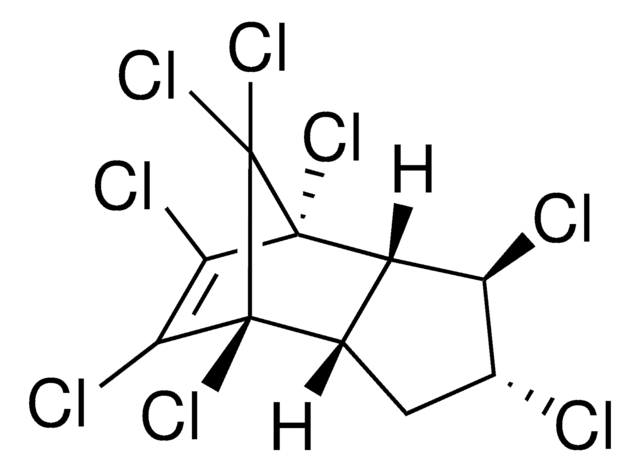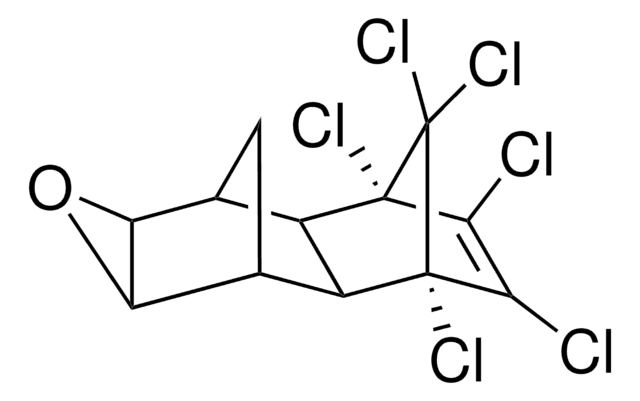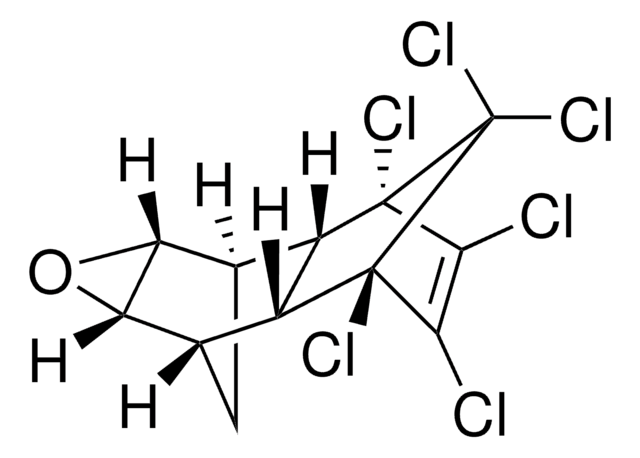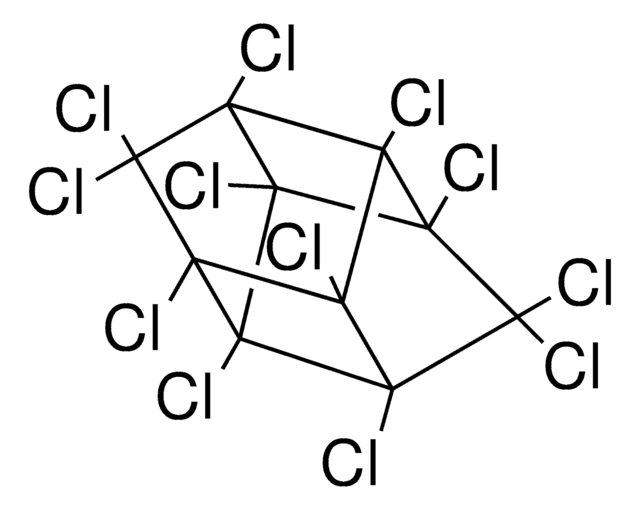推荐产品
等級
certified reference material
TraceCERT®
品質等級
描述
technical mixture
產品線
TraceCERT®
儲存期限
limited shelf life, expiry date on the label
製造商/商標名
Manufactured by: Sigma-Aldrich Production GmbH, Switzerland
形式
neat
儲存溫度
−20°C
SMILES 字串
ClC21C3C(C(C2(Cl)Cl)(C(=C1Cl)Cl)Cl)CC(C3Cl)Cl
InChI
1S/C10H6Cl8/c11-3-1-2-4(5(3)12)9(16)7(14)6(13)8(2,15)10(9,17)18/h2-5H,1H2
InChI 密鑰
BIWJNBZANLAXMG-UHFFFAOYSA-N
正在寻找类似产品? 访问 产品对比指南
一般說明
Chlordane is a synthetic organochlorine pesticide that belongs to the group of chlorinated cyclodiene. They are commonly resistant to photolytic, chemical, and biological degradation, and have relatively long half-lives. Chlordane manufactured as a technical form is composed of more than 120 structurally related compounds. The predominant isomers in technical chlordane are cis-chlordane (19%), trans-chlordane (24%), cis-nonachlor (2.7%), trans-nonachlor (9.7%), and heptachlor (10%).
Chlordane has to be monitored in the Multiannual Control Programmes for Pesticides Residues (MACP), run within the EU and EFTA in/on products of animal origin. Maximum residue levels (MRLs) have been set according to Reg (EC) No 149/2008 for chlordane (sum of cis-and trans chlordane) for various products of plant and animal origin from 0.01 to 0.005 mg/kg.
Technical chlordane was used mostly as an agricultural pesticide on corn and citrus, for home lawns and gardens, as well as a termiticide in house foundation. Chlordane blocks the gamma-aminobutyric acid (GABA)-gated chloride channels in the central nervous system, resulting in hyperexcitation and convulsions.
The use of chlordane as a pesticide has been banned in the EU since 1981 by Council Directive 79/117/EEC of 21 December 1978 which prohibited the placing on the market and use of plant protection products containing certain substances.
應用
It is intended to be used as a certified reference material (CRM) for calibration in chromatography and other analytical techniques. Chlordane in CRM may also find its use as described below:
- Study of joint toxic effects of polystyrene nanoparticles and chlordane and hexachlorocyclohexane pesticides on Caenorhabditis elegans
- Development of biomonitoring equivalents for chlordane and toxaphene with application to the general Canadian population
- To study chlordane, PCBs, and synthetic musk fragrances in a backwater area in the Upper Mississippi River and Iowa River
- QuEChERS method and a single instrumental analysis to detect a broad range of persistent organic pollutants (POPs) in white sturgeon liver and gonad tissues as an indication of exposure
- To investigate the effect of chlordane, heptachlor, and mirex, on hormonal regulation of the force of myometrial contractions in cow
法律資訊
訊號詞
Danger
危險分類
Acute Tox. 3 Dermal - Acute Tox. 3 Oral - Aquatic Acute 1 - Aquatic Chronic 1 - Carc. 2
儲存類別代碼
6.1C - Combustible acute toxic Cat.3 / toxic compounds or compounds which causing chronic effects
水污染物質分類(WGK)
WGK 3
我们的科学家团队拥有各种研究领域经验,包括生命科学、材料科学、化学合成、色谱、分析及许多其他领域.
联系技术服务部门











